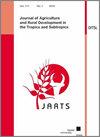Economic and financial returns of livestock agribusiness in high mountains of Nepal
Q3 Social Sciences
Journal of Agriculture and Rural Development in the Tropics and Subtropics
Pub Date : 2020-11-25
DOI:10.17170/KOBRA-202010191973
引用次数: 3
Abstract
Development partners and donor agencies often target programs and projects in poverty stricken and vulnerable regions around the world. However, there is paucity on economic and financial analysis of such investments. This study contributes to the literature by assessing financial internal rate of return (FIRR) and economic internal rate of return (EIRR) of livestock agribusiness, a vital component of ‘High Mountain Agribusiness and Livelihood Improvement’ (HIMALI) project supported by the Asian Development Bank (ADB) from 2011 to 2018 in ten mountain districts of Nepal. The analysis employs a unique dataset on annual cost (investment, operation and labour) and revenue of 138 livestock agribusiness from 2013 to 2017. The study estimates the EIRR and FIRR of six important livestock species namely, goat, sheep, mountain goat known as chyangra , chauri (a cross-bred of yak and local hill cow), cattle and pig raised in high uplands of Nepal. The overall EIRR of livestock agribusiness is 15% with the highest EIRR observed for sheep (18%), followed by goat (16%), chauri (14%), chyangra (14%) and pig (12%) farm enterprises. By contrast, the overall FIRR of livestock agribusiness is just 12%. Sensitivity analysis shows that the livestock agribusiness is highly sensitive to changes in revenue and operation costs. Some of the major challenges identified are lack of veterinary services and capital to scale-up agribusiness, inadequate market linkages, and limited pastureland. Among livestock agribusiness, sheep, goat, chyangra , and chauri has a high potential in high mountains. The low FIRR indicates a high risk to agribusiness. The study therefore recommends local, provincial and federal governments to deliver reliable extension services, improve market access and provide financial support to ensure the financial sustainability of livestock enterprises in the most difficult and economically lagged region of the country.尼泊尔高山畜牧业农业综合企业的经济和财务回报
发展伙伴和捐助机构经常针对世界各地贫困和脆弱地区的方案和项目。然而,对此类投资的经济和财务分析却很少。这项研究通过评估畜牧业农业综合企业的财务内部收益率(FIRR)和经济内部回报率(EIRR)为文献做出了贡献,畜牧业农业联合企业是亚洲开发银行(ADB)2011年至2018年在尼泊尔十个山区支持的“高山农业综合企业和生计改善”(HIMALI)项目的重要组成部分。该分析采用了一个关于2013年至2017年138家畜牧农业综合企业年度成本(投资、运营和劳动力)和收入的独特数据集。该研究估计了六种重要牲畜的EIRR和FIRR,即山羊、绵羊、被称为chyangra的山山羊、chauri(牦牛和当地山牛的杂交种)、尼泊尔高地饲养的牛和猪。畜牧业农业综合企业的总体EIRR为15%,绵羊的EIRR最高(18%),其次是山羊(16%)、chauri(14%)、chyangra(14%)和猪(12%)农场企业。相比之下,畜牧业农业综合企业的总体财务内部收益率仅为12%。敏感性分析表明,畜牧业农业综合企业对收入和运营成本的变化高度敏感。已确定的一些主要挑战包括缺乏兽医服务和扩大农业综合企业的资本、市场联系不足以及牧场有限。在畜牧业农业综合企业中,绵羊、山羊、chyangra和chauri在高山上具有很高的潜力。较低的FIRR表明农业综合企业的风险较高。因此,该研究建议地方、省和联邦政府提供可靠的推广服务,改善市场准入,并提供财政支持,以确保该国最困难和经济落后地区畜牧企业的财务可持续性。
本文章由计算机程序翻译,如有差异,请以英文原文为准。
求助全文
约1分钟内获得全文
求助全文
来源期刊
CiteScore
2.30
自引率
0.00%
发文量
0
审稿时长
>36 weeks
期刊介绍:
The Journal of Agriculture and Rural Development in the Tropics and Subtropics publishes papers dealing with original research and review papers in the fields of plant production, animal nutrition and animal husbandry, soil science, rural economy and farm management, forestry and forest economy, veterinary hygiene and protection against epidemics.

 求助内容:
求助内容: 应助结果提醒方式:
应助结果提醒方式:


